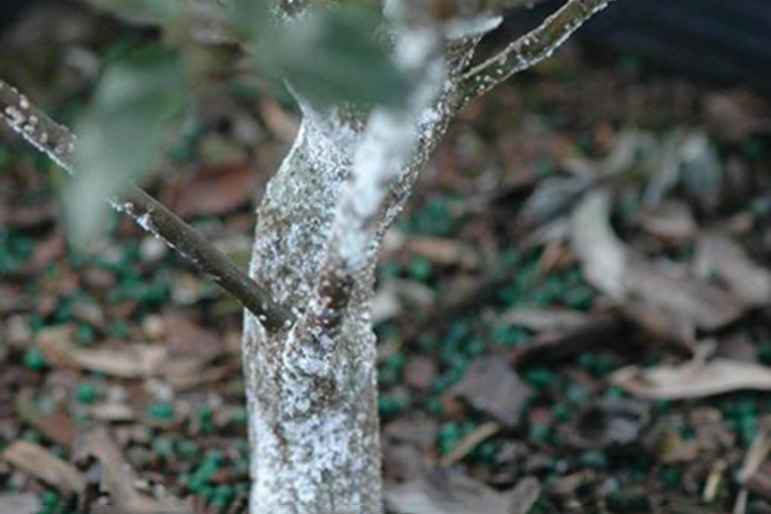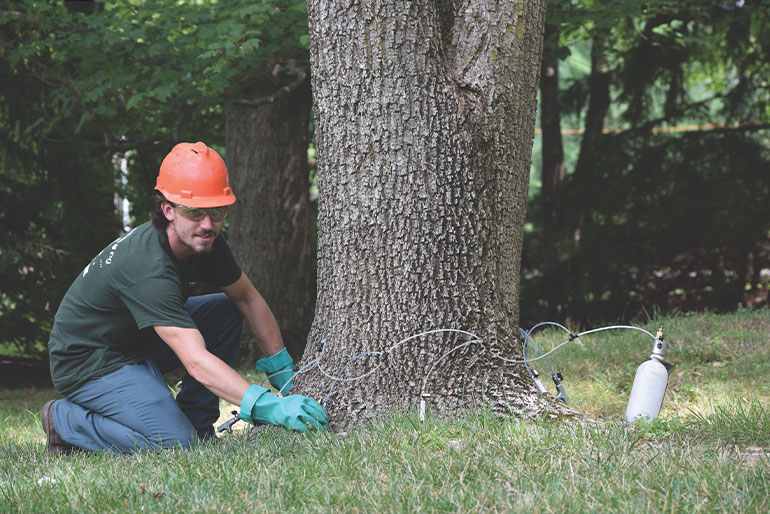
White Prunicola Scale
In 2021 we continued to battle White Prunicola Scale throughout the region. Its favorite host plants are cherry laurel, lilac, holly, and privet. Applying an insect growth regulator timed with the first egg-hatching in mid- to late May is crucial for managing this pest. Prunicola Scale typically has three generations in our area, so additional sprays are required to suppress the pest as it continues to reproduce, but properly timing the first egg-hatching is key. We often receive calls about terrible infestations later in the summer, by which time it is difficult to get ahead of the pest.
Spotted Lanternfly
Spotted Lanternfly (SLF) did a disappearing act in 2021. In 2020, we noticed SLF egg-laying in the western suburbs was drastically reduced, compared to 2019. As a result, we noticed far fewer nymphs and adults in our service area. So where did all the SLFs go? The dramatic reduction in egg-laying is not the result of weather or predation. The answer lies in the insect's behavior, evolution and favorite host plant, Ailanthus altissima, or Tree of Heaven.
In late summer and fall, Ailanthus begins its senescence, slowing the flow of sap to the leaves prior to fall leaf drop. This coincides with SLF’s heaviest feeding and egg-laying periods. With its preferred food source drying up, SLF has evolved to move to different hosts in the fall, sometimes moving great distances. Characterized by Penn State researchers as “flight dispersal”, this behavior is easily observed on hot, summer afternoons in areas with large SLF populations. SLFs are strongly attracted to vertical silhouettes, where they congregate in large numbers. They climb trees, telephone poles, or even apartment buildings, and then hop off, gradually fluttering down. Moving within about ten feet of another vertical object, they veer toward it to repeat the process. In late summer, with rising air currents, these flights can reach thousand of yards.
So, is Spotted Lanternfly gone forever? We don't think so. In fall of 2021, we saw a small return of SLF to some areas where no eggs had been laid the previous year. Although we don't expect numbers anywhere close to those of 2020, SLF might create a nuisance again this year. But we do not think SLF poses any significant threat to our ornamental trees and shrubs, and is easily controllable. We will continue to learn about this insect and keep our plants protected.
Emerald Ash Borer
Consider the Emerald Ash Borer (EAB) infestation as a giant wave that is about to crest in 2022. Nearly every ash tree in the entire Delaware Valley is either infested with EAB, protected by trunk injections, or dead. Once this wave crashes, the pressure will begin to ease. With fewer untreated ash trees attracting huge reservoirs of EAB, there will be fewer attacks on treated trees. Eventually, we hope the trunk injection we use to protect ash trees will get to 3-year control. This will help economically, while allowing more time for ash trees to heal from the injection process. We will keep monitoring EAB numbers and increasing the treatment interval conservatively as needed. We do not want to leave any ash trees vulnerable to this 100% lethal pest.
Deicing Salt Damage
Every winter, deicing salt applied to our roads and walkways helps us commute and move safely after a storm. A useful tool, however, these lingering products affect tree and shrub health each spring. Excess salt in the soil draws water directly from nearby roots by natural osmotic pressure, displacing other nutrients such as magnesium, potassium, and calcium. The result is a localized drought and nutrient deficiency for an affected tree. It can take up to six inches of rain to flush salt-laden soil back to levels that allow those roots to function normally. Soil testing and fertilizing may also be needed to repair the soil and the tree.
Ways to mitigate damage from road salt? Install physical barriers along the road to protect trees, choose trees and shrubs with higher tolerance to salty soils, and irrigate to flush salt out of the soil prior to spring growth. When applying salt, be sure to use the best product available. An alternative to sodium chloride, calcium chloride, is more expensive but far less damaging.

English ivy, Hedera helix is an evergreen groundcover and climbing vine hardy in the Philadelphia area. Long utilized as a ground cover, the...

The Arboretum at Laurel Hill is collaborating with Cornell University to grow hybrid oak trees at their cemetery in Bala Cynwyd.
The project was...

Oak Wilt
Oak wilt has always been one of those diseases that we were happy to not have to deal with. We were aware...